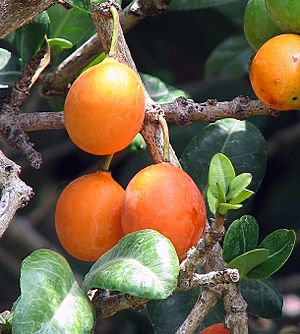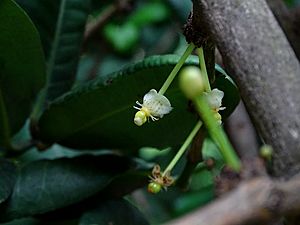African mangosteen facts for kids
Quick facts for kids African mangosteen |
|
|---|---|
 |
|
| Scientific classification | |
| Genus: |
Garcinia
|
| Species: |
livingstonei
|
The Garcinia livingstonei, also known as the African mangosteen or imbe, is a type of tree found across many parts of Africa. You can find it from countries like Côte d'Ivoire all the way to Somalia in the east, and down to South Africa in the south.
This tree is an evergreen, which means it keeps its leaves all year round. It can grow to be a small tree, usually between 6 and 18 meters (about 20 to 60 feet) tall. Its leaves are blue-green and shaped like ovals. They grow in pairs or in groups of three or four. Each leaf is about 6 to 11 centimeters (2.5 to 4.5 inches) long.
The tree produces flowers in small groups right on its stems. The fruit is a small, bright orange berry with thin skin. It's usually 1 to 4 centimeters (about 0.4 to 1.6 inches) wide and has one large seed inside. The fruit is sweet and a little bit tart. It also contains a sticky sap called latex, which some people might find a bit unusual.
Growing and Using African Mangosteen
The African mangosteen has been a traditional food plant in Africa for a long time. Even though it's not very well-known, this fruit could help improve nutrition and food security in many places. It can also help local communities and support good land care.
People mostly grow this tree because it's pretty and makes nice fruit. While it's often eaten fresh, you can also use the fruit to make drinks. The juice from the fruit can cause very bad stains, so be careful! This tree can even be grown in places like southern Florida.
To get fruit from an African mangosteen tree, you usually need both a male and a female plant. However, you can also graft (attach parts of) both male and female plants onto the same tree to make it produce fruit.
Gallery





